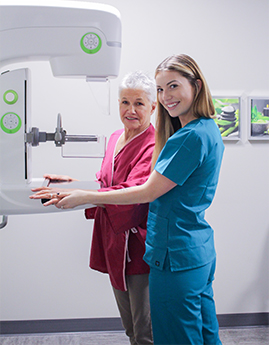Intervention - Breast Biopsy
Intervention, or breast biopsy, is a minimally invasive alternative to surgical biopsy in assessing breast disease. Breast intervention may be diagnostic, therapeutic, or both. Where surgical biopsies can be excisional (remove an entire lump), the goal of breast biopsy is to remove a small piece of the lump for examination. The small sample is then tested and classified by pathologists in a laboratory.
All breast biopsies rely on diagnostic imaging to locate the abnormality of interest. Insight Medical Imaging relies on mammography or ultrasound guidance for breast biopsy procedures. We offer different interventional methods at our Lendrum Women’s Imaging and Meadowlark Diagnostic locations.
Sometimes a patient and doctor will decide that surgical biopsy is the best course of action. In those cases, our team will work closely with your surgeon by providing needle wire localization before surgical intervention.
Breast Biopsy Intervention Procedures:
Ultrasound Guided Core Biopsy
During this procedure, a hollow needle is used to take a small cylinder-shaped sample of tissue from a lump or abnormality using ultrasound guidance. This biopsy method uses high-frequency sound waves, not ionizing radiation, to locate the abnormality. As with all our breast intervention procedures, scarring is highly unlikely because this procedure does not require stitches following the biopsy.
Fine-Needle Aspiration Biopsy
Fine needle aspiration biopsy (FNA) is an ultrasound-guided biopsy that uses a very thin needle and syringe to remove a small amount of tissue or fluid for classification. At Insight Medical Imaging, FNA is most commonly used in draining fluid from palpable or pain-causing cysts. Since this form of intervention uses ultrasound guidance, there is no exposure to ionizing radiation.
Stereotactic Core Biopsy
During stereotactic core biopsy, a special hollow needle is used to take a small cylinder-shaped tissue sample from a calcium accumulation under mammographic guidance. This procedure is less invasive than a surgical biopsy and is a great alternative to evaluate calcifications that cannot be felt by your doctor or seen on ultrasound.
Additionally, mammographic guidance used in stereotactic biopsies helps to locate the abnormality by obtaining images of the biopsy target from two slightly different angles so the needle can be inserted with absolute precision.
Tomosynthesis Guided Biopsy
Tomosynthetic biopsy, also known as DBT biopsy, is a vacuum-assisted biopsy that relies on tomosynthesis to remove a small amount of tissue for identification. This form of biopsy does an excellent job with lesion visualization (masses, arch distortions, and asymmetries). High depth-resolution is directly correlated with precision and the most important factor in any biopsy.
The main advantage of DBT biopsy is the wide-angle system that allows for greater depth resolution and increased biopsy precision. The additional precision in tomosynthetic biopsy means faster scanning, less radiation exposure, and shorter procedure time.
Wire Localization
Wire localization is used to pinpoint the exact location of an abnormality for a surgeon before surgical intervention. Once the abnormality is located within the breast using either ultrasound or mammography guidance, local freezing is used to numb the area.
Our radiologist will insert a hollow needle into the breast and feed a thin wire through the syringe. The wire has a hook at the end to prevent it from moving. Once the wire is in place, the needle is removed. Our team will tape the wire to the breast and then acquire any additional imaging for your surgeon. Finally, we will send you to the hospital for surgery.
Sentinel Lymph Node Imaging
Sentinel lymph node imaging, also known as lymphoscintigraphy, uses nuclear medicine and radiopharmaceutical tracers to capture images of the lymphatic system. This type of imaging is performed to locate the initial lymph node that is a candidate for drainage and to identify points of blockage in the lymphatic system. Insight Medical Imaging primarily uses this procedure to help prepare our patients for excisional surgical biopsy.
What Happens During my Breast Biopsy?
- The technologist will review the consent form with you and answer any questions you have.
- You will be asked to change into a gown, removing your clothing from the waist up; your breast will need to be visible for the exam.
- We will conduct a preliminary scan to assess the area of interest.
- To ensure our patients are as comfortable as possible during the preliminary scan, only female technologists scan when a breast is exposed.
- You will be escorted to your exam room and introduced to the radiologist conducting your biopsy.
- Occasionally a male Radiologist will perform your breast biopsy. In these cases, we always ensure another female is present during the procedure.
- The radiologist will administer a generous amount of local freezing and guide a thin cylinder into the correct position using ultrasound or mammography (stereo) guidance.
- The radiologist will confirm the location through multiple viewing angles and inform you when the procedure has finished.
- A dressing will be placed over the treatment area, and the technologist will answer any questions or concerns you have after the procedure.
- You will receive a post-care information sheet to help answer any questions that may arise.
Please note, breast intervention biopsy procedures may vary depending on the specific method requested by the doctor and different radiologists. However, most will follow the above outline.
Cost
If you have an Alberta Health Care card or valid healthcare card from out of province, there is no cost for breast intervention procedures (except Quebec).
Duration
Breast intervention procedures take approximately 60 to 90 minutes, depending on the number of sites to be examined.
Exam Preparation
Being prepared for your breast biopsy helps us take the best possible samples for diagnosis. Please visit our exam prep page for more instructions specific to breast intervention.



